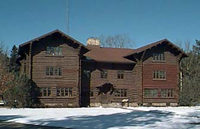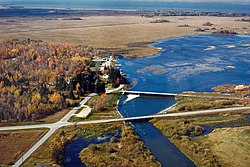

| Chippewa National Forest | |
|---|---|
 | |
|
| |
| Location | Itasca / Cass / Beltrami counties, Minnesota, United States |
| Nearest city | Cass Lake, MN |
| Coordinates | 47°20′26″N 94°12′24″W / 47.34056°N 94.20667°W / 47.34056; -94.20667 |
| Area | 666,623 acres (2,697.73 km2)[1] |
| Established | 1908 |
| Governing body | U.S. Forest Service |
| Website | Chippewa National Forest |

Chippewa National Forest is a National Forest located in north central Minnesota, United States, in the counties of Itasca, Cass and Beltrami. Forest headquarters are located in Cass Lake, Minnesota. There are local ranger district offices in Blackduck, Deer River and Walker.

The Forest was established as the Minnesota Forest Reserve on 27 June 1902, with the passage of the Morris Act.[2] While this act mainly addressed the disposition of unallotted lands on Ojibwe Indian reservations in Minnesota, 200,000 acres (810 km2) of the Chippewas of the Mississippi, Cass Lake, Leech Lake, and Winnibigoshish Indian reservations were designated as a Forest Reserve.
Led by Maria Sanford and Florence Bramhall of the Federation of Minnesota Women's Clubs, conservation activism beginning in 1900 brought the forest and potential threats to wide public attention.[3] The Reserve was re-established as the Minnesota National Forest on 23 May 1908.[4] In 1928, the forest was renamed in honor of the Chippewa tribe of Native Americans from whose land the forest was created. Subsequent boundary expansions and land purchases increased the area of the forest to its present size.
The Forest contains an area known as the 'Lost Forty. This area, which has a total of 144 acres (0.58 km2), was accidentally mapped as part of Coddington Lake when the original maps of the region were laid out in 1882.[5] As a result of the mapping error, the Lost Forty was never logged. It contains some of the state's oldest forests, with trees over 350 years old. Today, less than two percent of Minnesota's total forested land is such old growth forest.

There are over 3000 archeological and historic sites located within the forest, two that are most notable and open to the public are:
The forest covers 667,094 acres (2,699.63 km2). Water is abundant, with over 1,300 lakes, 923 miles (1,485 km) of rivers and streams and 400,000 acres (1,600 km2) of wetlands.[6] The Forest has more lakes and wetlands than any other National Forest in the nation, boasting approximately 13% of all surface water within the entire National Forest system.[7] Inside the forest the Cut Foot Sioux Trail runs along the Laurentian Divide.
Three of the top ten largest lakes in size within the State of Minnesota are located within the forest, these are Cass Lake, Leech Lake and Lake Winnibigoshish. Approximately 44% of the Forest's land is within the Leech Lake Indian Reservation.
Aspen, birch, pine, balsam fir, and maple blanket the forest. Old growth forest such as the Lost Forty section of the CNF is valuable for wildlife, including bald eagle, several species of hawk and woodpecker, red squirrel, weasel, and numerous other species. In the 1960s, the bald eagle population in the forest was only 12 nesting pairs.[8] Since then the population has rebounded. The bald eagle population of the Chippewa National Forest is one of the highest densities in the lower 48 states at 150 nesting pairs.[9]

The Forest contains 21 developed campgrounds, 41 miles of paved bike trails, 43 miles of unpaved bike trails, 160 miles of hiking trails, 298 miles of non-motorized trails, 380 miles of snowmobile trails, 68 dispersed camping locations, 20 miles of horse trails, 83 boat accesses.[10]
A highlight of the Forest's trail system is the 60-plus mile segment of the North Country National Scenic Trail that parallels State Highways 34 and 200 and features backpacking campsites along its route. Find an interactive map of the Trail's route at the North Country Trail Association's website.
The Forest operates three visitor centers in the forest, they are:[11]
Many roadways, including U.S. and State Highways and county roads, intersect the forest for easy access to the forest. Within the Forest are five scenic byways for scenic drives for visitors that intersect through the forest.[12]
{{cite web}}: Missing or empty |title= (help)[title missing]
{{cite web}}: Missing or empty |title= (help)[title missing]
|
National Forests of the United States
| |
|---|---|
| |
|
| International |
|
|---|---|
| National |
|
| Other |
|